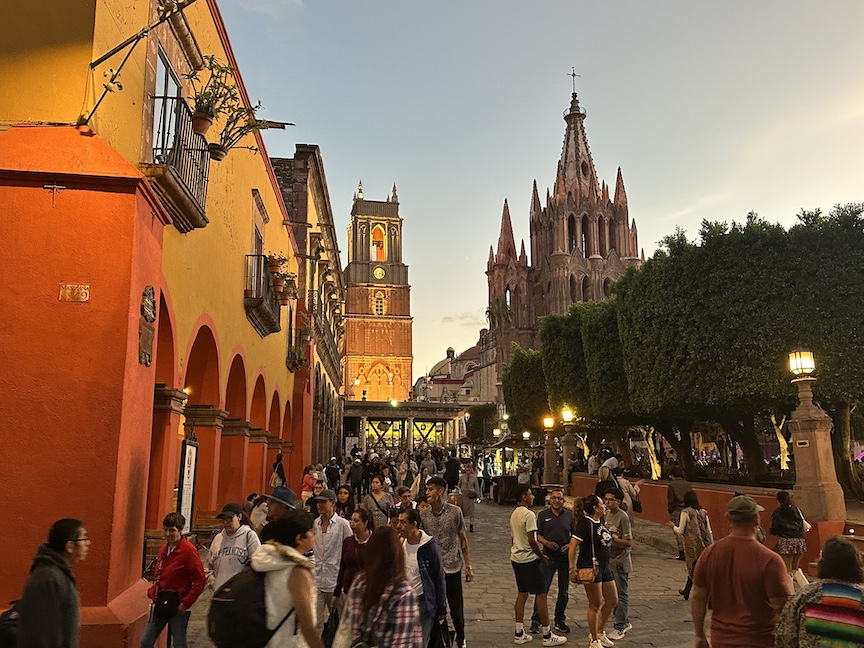
San Miguel has a growing population but it remains a sociable town where residents come out on the streets at dusk to greet their neighbors. Photo by Ramaa Reddy
By Ramaa Reddy
San Miguel de Allende lies in the Eastern part of Mexico’s State of Guanajuato, about a three-hour journey from Mexico City. It’s a cobblestoned colonial town with pastel-colored buildings that has changed a lot over the past century yet remained remarkably the same.
Jana Kolpen from New York City says she first heard about San Miguel from her mother who visited in the 1980s. “My mother would say, ‘It’s so beautiful, they have artists, and everyone is nice.’ These words remained in my head,” says Kolpen.
In 2017, Kolpen and her husband Doug took the plunge and moved lock, stock, and barrel to San Miguel. They have not regretted it. “It’s a friendly place for both expats and Mexicans. It’s magical and beautiful,” Kolpen adds.
Kolpen’s sentiments are shared today with some 10,000 other foreign residents who call San Miguel home, not just for its beauty but also for its low cost of living, excellent medical care and low crime rate.
History and Architecture
On arriving in San Miguel, visitors are drawn to the main square or Jardin Principal. Canopied by trees, it’s a popular local hangout where Mariachi bands roam about awaiting a paying customer. On the Northern corner stands the majestic Catholic church – Parroquia de San Miguel Arcángel. Constructed with pink stone, the church was finished in the 18th century and is a replica of a German cathedral, but its style is a mix of Mexican and medieval Gothic. Its vertical proportions and pointed arches stand out during dusk and when lighted at night.
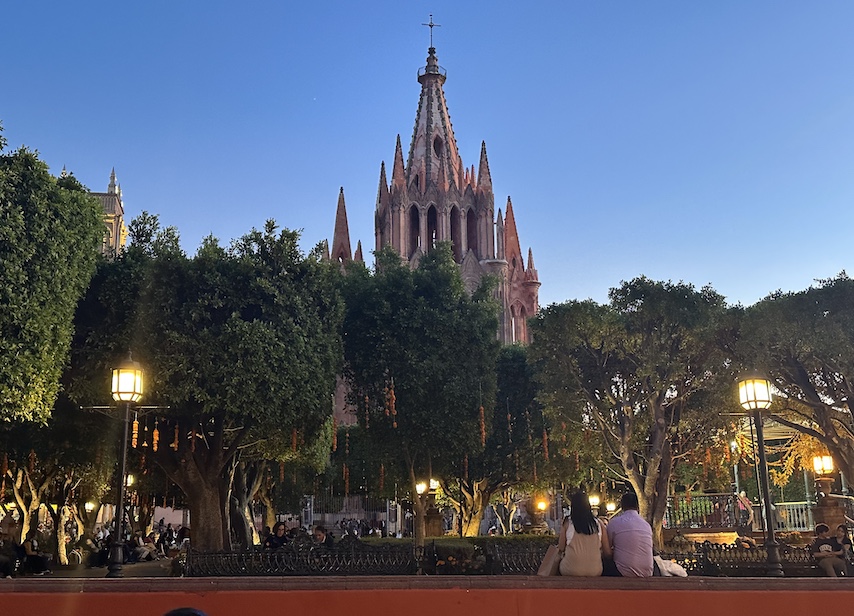
In San Miguel de Allende all roads eventually lead to the main square, Parroquia de San Miguel Arcángel. Photo by Ramaa Reddy
The Spanish who arrived in the 16th century colonized this part of Latin America and discovered silver mines in its neighboring towns making San Miguel an important outpost for the Spanish crown and attracting wealthy barons who in turn invested in its architecture.
Across from the church is the home of, Ignacio Jose de Allende y Unzaga, San Miguel’s native son and eponymous hero. Born in 1779 to a wealthy Creole family, Allende was an officer in the Spanish Army of New Spain who sympathized with Mexico’s 1821 Independence movement and switched sides.
Artists and writers flocked to the town after 1937 when well-known Peruvian artist Felipe Cossio del Pomar received permission to start an art school called Bellas Artes. The school attracted Sterling Dickinson who was instrumental in promoting the school throughout the wider artistic community. By the late 1940s, the school’s success was firmly established thanks to the 1945 GI Bill that provided free education to U.S. military veterans seeking to become artists.
In 2008 San Miguel de Allende was designated a UNESCO World Heritage Site for its Mexican-Baroque and Neo-Classic architecture.
As more foreigners arrived, they quickly discovered the city’s affordable, patient-centered health care. Saya Kolpen: “Here they practice old-fashioned medicine where you pay $40-$50 for an office visit that lasts an hour; doctors spend time explaining all your x-rays and PET scans.”
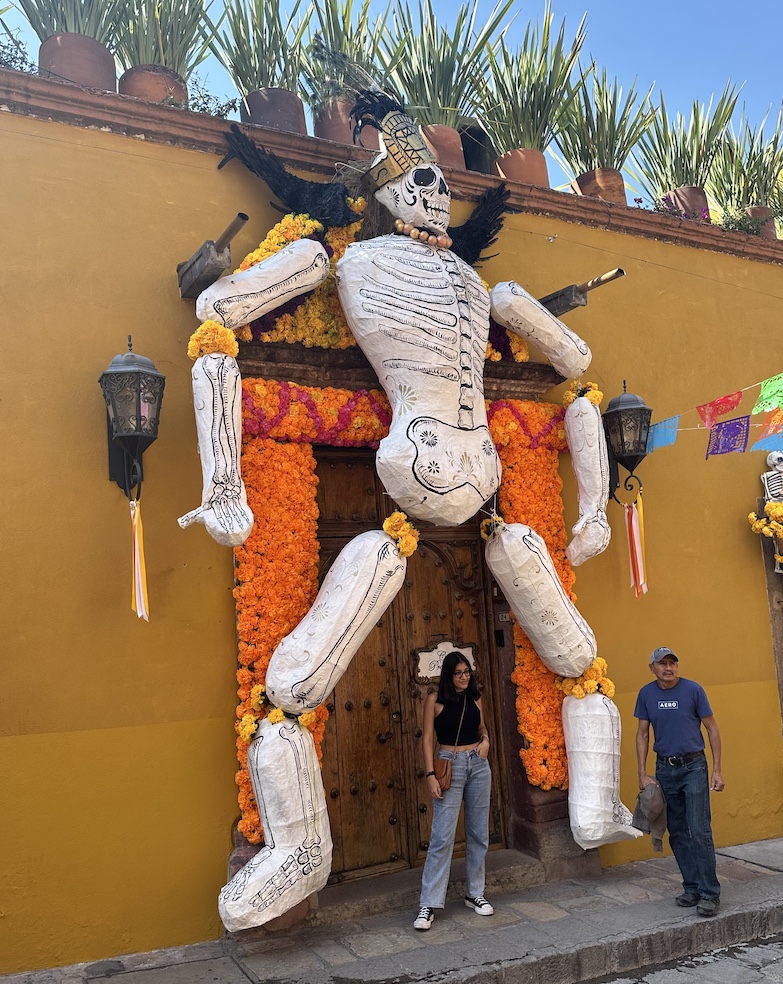
A doorway decorated for Dia de los Muertos is an Instagramable stop for San Miguel tourists. Photo by Ramaa Reddy
Always Lively: Día de los Muertos, or Day of the Dead
A not-to-be-missed celebration occurs in early November when the town is transformed into a vibrant carnival. The festival is a mix of Catholicism (All Saints Day and All Souls Day) with Aztec rituals based on the belief that once a year the dead can awake and be remembered. For a few days, the city is transformed with streets lined with ribbons and doorways decorated with marigolds. Shopkeepers create ofrendas (offerings) while makeup artists set up pop-up studios on the main square for locals and tourists to remake themselves as Catrina, the lady of the afterlife who presides over festivals and parades.
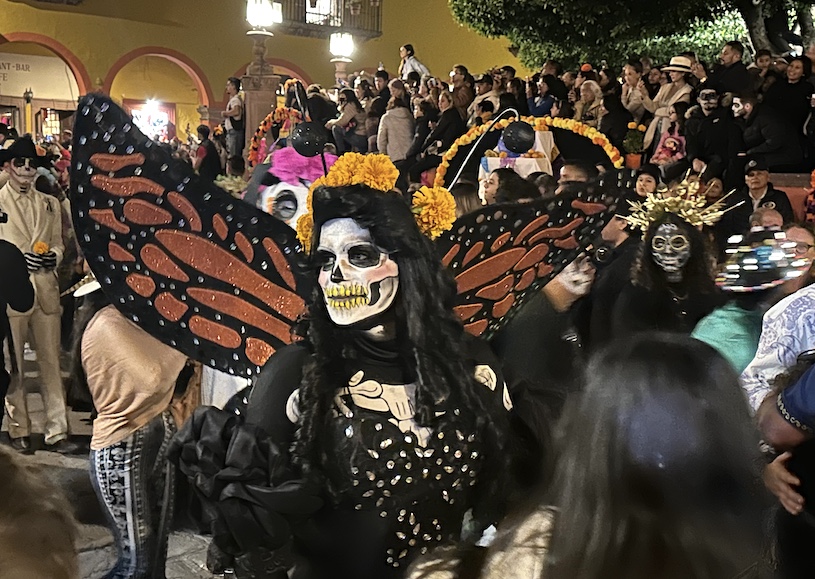
The Catarinas parade in San Miguel de Allende is a festive occasion. Photo by Ramaa Reddy
Every home creates an ofrenda with photographs of beloved ancestors who are placed on a raised altar to mark their significance. The altar is graced with favorite foods of the deceased along with candles, calaveras (human skulls), and Terciopelo flowers – items meant to guide the soul to the other world. During the season, temporary markets materialize near the civic plaza to sell confectionaries and other decorative elements for the ofrenda.
“The celebration comes from the Mayans,” says Rosana Alvarez, co-owner of Casa Angelitos, a boutique hotel in San Miguel. “On the first and second of November we visit cemeteries to remember lost ones, and down south people make tamales all night long to connect with the dead. Tamales represent the person who died – like putting the body and wrapping it.”
Día de Muertos gained popularity this decade thanks to the 2017 Disney movie Coco and the 2015 James Bond film Spectre – which begins with a Day of the Dead parade in Mexico City. Interestingly, the parade was non-existent before the film but now is an annual event thanks to Hollywood.
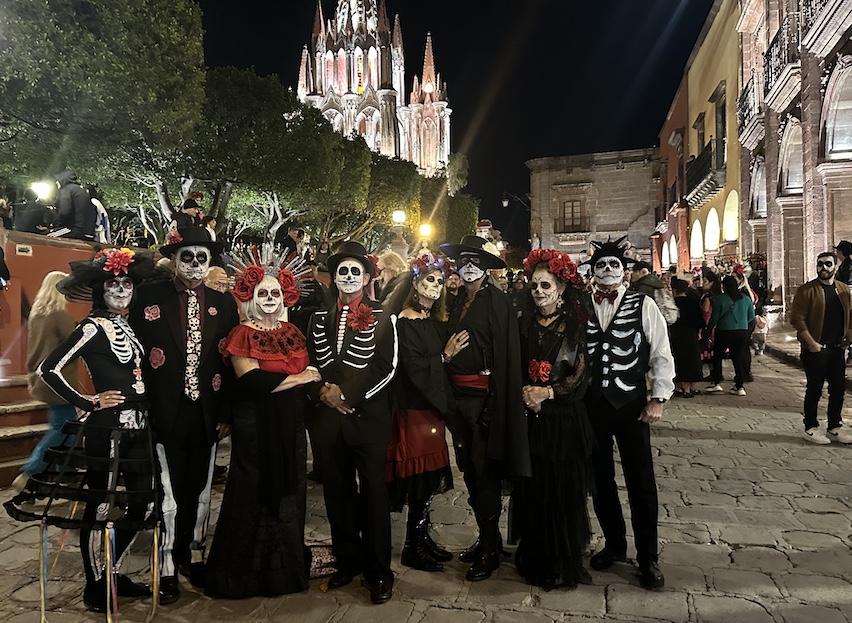
Tourists from Louisiana assemble for a Dia de los Muertos stroll around San Miguel. Photo by Ramaa Reddy
Kolpen says she has enjoyed this annual tradition as it’s a welcome way to revisit family and friends who have passed – those you normally forget about. “It’s beautiful to see how Mexicans handle death with ceremonies, altars, parties, and festivities. The best place to visit is the cemetery because they have picnics by the graves and put all kinds of things to attract the soul back to them for the day.”
Where Afterlife Means Life Ever After
Guanajuato, the neighboring capital of the region, is another UNESCO World Heritage site recognized for its colonial-era architecture, narrow streets, and alleyways. The main draw here is the house in which Diego Rivera – Mexico’s famous muralist – was born. The house was opened in the 1970s to the public as a museum and houses period furniture as well as paintings from various stages of his life.
A close-by and popular attraction during this season is a visit to the Museum of the Mummies of Guanajuato, a museum that transpired by happenstance. In the mid-1800s, locals upon their death were buried in the Santa Paula cemetery. Soon the cemetery was full and those unable to pay the cemetery tax had to vacate their space for a paying customer and their bodies were exhumed and put into crypts under the cemetery where the museum is now located.
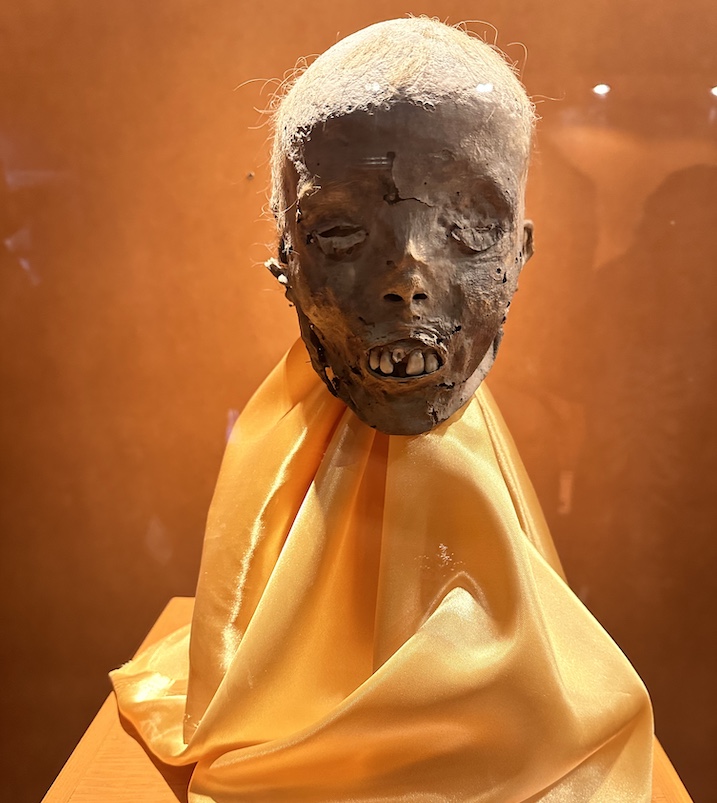
Soulful yet Silent. An inhabitant of the Museum of the Mummy in Guanajuato has a story to tell but can’t find the words. Photo by Ramaa Reddy
Interestingly, the lack of oxygen and humidity in the crypt created a perfect milieu that prevented bodies from decomposing resulting in the creation of well-preserved mummies. Many of the mummies on display are pale with creepy body contortions and disturbing facial expressions but the museum remains one of the most popular in Mexico and the wait to enter can often be long. One of the earliest mummies displayed is that of a French doctor, Remigio Leroy, an immigrant who was disinterred in 1865.
Saludos a Todos
Since 2016 San Miguel’s restaurant scene has bourgeoned. Chicago transplant Susan Knight York has been living and covering the food scene in San Miguel for the last 10 years.
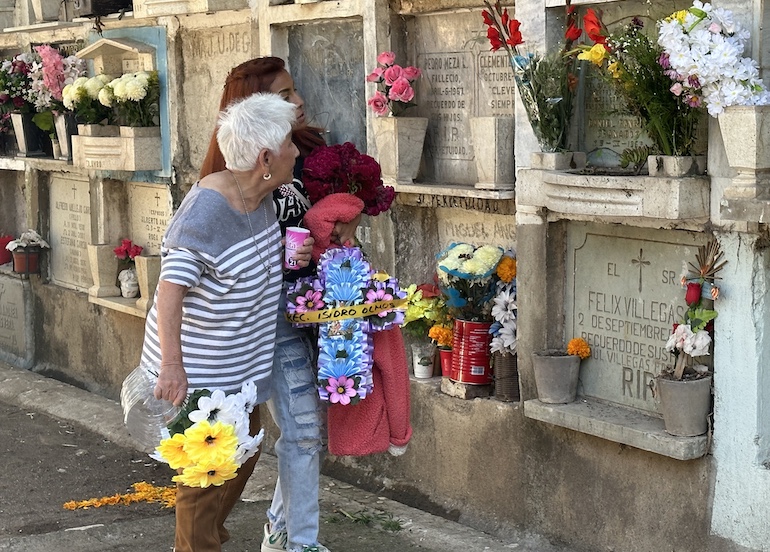
Visitors spending a day with the dead at the Santa Paula cemetery in Guanajuato. Photo by Ramaa Reddy
“When I moved here, the only good restaurant was The Restaurant,” she admits with a sigh. “I was unhappy since I came from a big culinary city. But today things have improved greatly,” she smiles while sampling the crunchy Red Snapper at her favorite restaurant, Atrio. Led by chef Arturo Sandoval, Atrio is around 6 years old with a mainly Mexican customer base. The Duck Gyozas, a dumpling made with Peruvian chilis, and Black Rib Rice cooked at high temperatures in a Josper oven are some of the specialties. In addition to the delicious food, the picturesque setting offers an unobstructed view of the Parroquia de San Miguel Arcángel.
A stenciled painting of San Miguel on an edible wafer is the signature welcome drink to every new visitor to the city. The cocktail, known as La Costumbre is made with pineapple juice and Mezcal Lineal and can be found a block away at Bovine above an art gallery that profiles some famous Mexican chefs who have influenced the food scene. Among them is Donnie Masterton, a Californian, who some say played an instrumental role in the transition.
York’s other restaurant suggestions are Estoril for good French food, Aperi, and La Azotea. For unbelievable street food, she recommends Andy’s tacos, Tacos Ramirez, and the Bautista Brothers for excellent carnitas.
With food comes wine and San Miguel’s wine scene has had a resurgence in the last five years. Tiffany Pence who heads Heart of Mexican Wine Tours with her husband Tom, says that the three wineries – Dos Buhos, Cuna De Tierra, and Tres Raices – are among the best in the region. The couple says Dos Buhos covers 29 acres and has been run by one family for three generations. In the 1950s, the family grew peaches but changing weather patterns prompted a transition to winemaking.
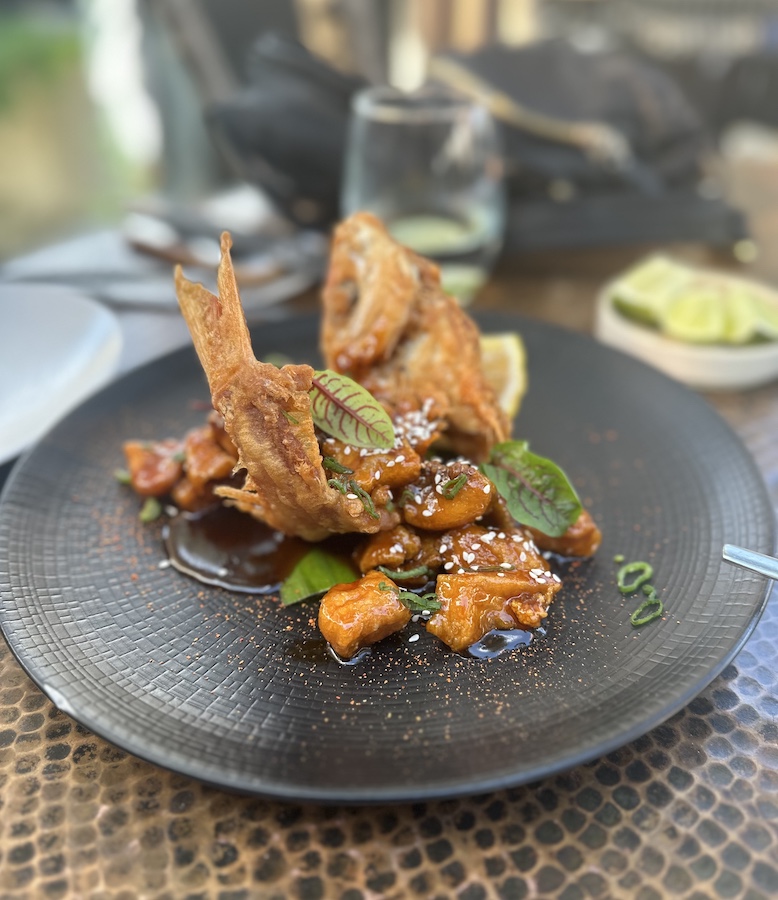
Crunchy Red Snapper at Ario. Photo by Ramaa Reddy
Framed by the Picacho mountain range, the winery produces some good white and red wines, which are stored in tanks and barrels. Since the weather is similar to Spain, the grapes planted are mainly Spanish noble grapes from the Rioja or Ribera del Duero region in Spain. Thus, according to Pence, their Cabernet Franc and Tempranillo varietals are climatically correct.
With all these amenities, it’s no wonder that ex-pats flock to San Miguel de Allende and continue to be allured by its moderate climate, affordable living, friendly atmosphere, and compelling cuisine.
Roger Jones, husband of Alvarez and co-owner of Casa Angelitos, has been residing in San Miguel for over 30 years. He conveys this sentiment succinctly: “This is an art center and it’s got incredible weather with puffy clouds,” says Jones.
“Even though the city has grown from 20,000 to over 100,000 we still keep our essence, unlike Mexico City or Guadalajara. It’s a colonial place built with stone and rock where everyone knows your name.”![]()
Ramaa Reddy is a graduate of the Columbia School of Journalism. Her previous EWNS story focused on the ancient city of Petra.

